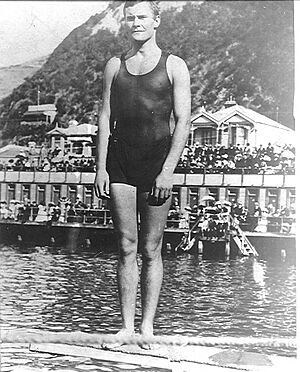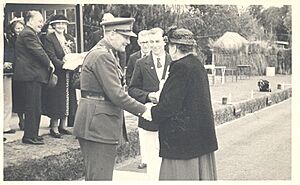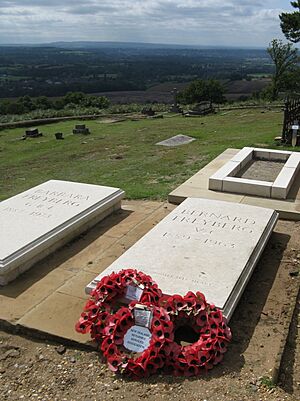Bernard Freyberg, 1st Baron Freyberg facts for kids
Quick facts for kids
The Lord Freyberg
|
|
|---|---|
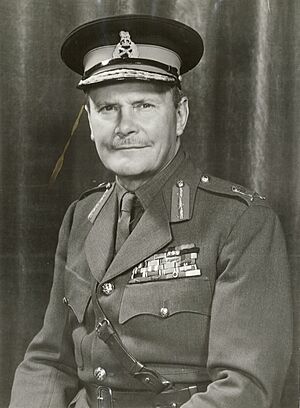
Bernard Freyberg in 1952
|
|
| 7th Governor-General of New Zealand | |
| In office 17 June 1946 – 15 August 1952 |
|
| Monarch | George VI Elizabeth II |
| Prime Minister | Peter Fraser Sidney Holland |
| Preceded by | Sir Cyril Newall |
| Succeeded by | Sir Willoughby Norrie |
| Member of the House of Lords Lord Temporal |
|
| In office 19 October 1951 – 4 July 1963 |
|
| Preceded by | Peerage created |
| Succeeded by | The 2nd Lord Freyberg |
| Personal details | |
| Born | 21 March 1889 Richmond, London, England |
| Died | 4 July 1963 (aged 74) Windsor, Berkshire, England |
| Political party | Liberal |
| Nickname | "Tiny" |
| Military service | |
| Allegiance | United Kingdom (1914–37) New Zealand (1939–45) |
| Branch/service | Royal Naval Volunteer Reserve British Army New Zealand Military Forces |
| Years of service | 1914–1937 1939–1945 |
| Rank | Lieutenant-general |
| Unit | Queen's Royal Regiment (West Surrey) Grenadier Guards Manchester Regiment |
| Commands | X Corps (1943) 2nd New Zealand Division (1939–45) 2nd New Zealand Expeditionary Force (1939–45) Salisbury Plain Area (1939) 1st Battalion, Manchester Regiment (1929–31) 88th Brigade (1917–18) 173rd (3/1st London) Brigade (1917) |
| Battles/wars | First World War Second World War |
| Awards | Victoria Cross Knight Grand Cross of the Order of St Michael and St George Knight Commander of the Order of the Bath Knight Commander of the Order of the British Empire Distinguished Service Order & Three Bars Mentioned in Despatches (6) Knight of the Venerable Order of St. John Croix de Guerre (France) Legion of Merit (United States) Grand Commander with Swords of the Order of George I (Greece) Cross of Valour (Greece) War Cross (Greece) |
Lieutenant-General Bernard Cyril Freyberg, 1st Baron Freyberg (21 March 1889 – 4 July 1963) was a brave soldier. He was born in Britain but became a New Zealander. He earned the Victoria Cross, a very high award for bravery. Later, he served as the 7th Governor-General of New Zealand from 1946 to 1952.
Freyberg was an officer in the British Army during the First World War. He was part of the beach landings in the Gallipoli campaign. He became the youngest general in the British Army during that war. He also fought on the Western Front. There, he received the Victoria Cross and three Distinguished Service Orders. This made him one of the most decorated soldiers of the First World War. He loved being in the middle of the action. Winston Churchill even called him "the Salamander." This was because he seemed to pass through danger unharmed.
During the Second World War, he led the New Zealand Expeditionary Force. They fought in the Battle of Crete, the North African campaign, and the Italian campaign. He faced tough challenges, including defeats in Greece and Crete. However, he led the 2nd New Zealand Division successfully in North Africa. This included the important Second Battle of El Alamein.
In Italy, he faced another defeat at the Second Battle of Cassino. But he later helped free cities like Padua and Venice. He was also one of the first to enter Trieste. By the end of the Second World War, Freyberg had spent many years fighting.
Contents
Early Life and Adventures
Bernard Freyberg was the youngest of five boys. He was born in Richmond, England. When he was two, his family moved to New Zealand.
He went to Wellington College from 1897 to 1904. He was a very strong swimmer. He won the New Zealand 100-yards swimming championship in 1906 and 1910.
In 1911, Freyberg became a qualified dentist. He worked in different towns in New Zealand. He tried to join the local army unit but didn't get a commission.
In March 1914, Freyberg left New Zealand. He traveled to San Francisco and Mexico. Some stories say he was a captain under Pancho Villa during the Mexican Revolution.
When he heard about the First World War starting in Europe, he went to Britain. He earned money for his journey by winning a swimming competition in Los Angeles and a boxing match in New York.
First World War Hero
When the First World War began in August 1914, Freyberg quickly went to England. He volunteered to serve. He joined the Royal Naval Brigade. By late 1914, he met Winston Churchill, who was then in charge of the Navy. Churchill gave him a special commission in the 'Hood' Battalion.
In April 1915, Freyberg was part of the Dardanelles campaign. On the night of April 24, he bravely swam ashore in the Gulf of Saros. He lit flares to distract Turkish forces from the main landings at Gallipoli. He returned safely and received the Distinguished Service Order (DSO) for his courage. He was wounded many times during this campaign.
Winning the Victoria Cross
In May 1916, Freyberg joined the British Army. He became a captain in the Queen's Regiment. He then went to France with his battalion.
During the Battle of the Somme, he showed incredible bravery. He was leading a battalion as a temporary lieutenant-colonel. He led his men to capture Beaucourt village. For this, he was awarded the Victoria Cross (VC).
On November 13, 1916, in France, his battalion attacked enemy trenches. Despite heavy fire, Freyberg gathered his disorganized men. He led them to capture the next objective. He was wounded twice but kept leading. He held his ground all day and night. The next morning, he attacked and captured a fortified village, taking 500 prisoners. He was wounded twice more, but he refused to leave until he gave his final orders.
His bravery and leadership helped secure a key position. This position allowed the army to form a strong line.
Freyberg continued to lead by example on the Western Front. His bold style came at a cost. He was wounded nine times in France. People who served with him later said his body was covered in scars.
He was promoted to temporary brigadier general in April 1917. This made him the youngest general officer in the British Army. He received another award, the Companion of the Order of St Michael and St George. In September, a shell exploded near him, causing one of his worst wounds.
When he returned to duty in January 1918, he led the 88th Brigade. He performed very well during the German attacks in March–April 1918. He earned a second DSO in September that year.
Freyberg ended the war by capturing a bridge at Lessines. He did this just one minute before the war officially ended on November 11, 1918. This earned him a third DSO. By the end of the war, he had also received the French Croix de Guerre. He was mentioned in official reports five times. With his VC and three DSOs, he was one of the most decorated soldiers of the First World War.
Between the Wars
After the war, Freyberg joined the Grenadier Guards. He also tried to swim the English Channel. He attended Staff College from 1920 to 1921. He had health problems from his many war wounds. In 1921, he visited New Zealand to recover.
On June 14, 1922, he married Barbara McLaren. She had two children from a previous marriage. Bernard and Barbara later had a son named Paul (1923–1993).
He was promoted to major in 1927. In 1929, he became a lieutenant-colonel and commanded the 1st Battalion, Manchester Regiment.
In 1931, he was promoted to colonel. He wrote a book called A Study of Unit Administration. This book became a textbook for army logistics.
In 1934, he became a major-general at age 45. He seemed set for a high army career. However, medical exams showed a heart problem. Despite his efforts, Freyberg had to retire from the army in 1937.
Second World War Leadership
Even though he was considered unfit in 1937, Freyberg returned to active service in 1939. The New Zealand Government asked him to lead their forces. He became the commander of the 2nd New Zealand Expeditionary Force and the 2nd New Zealand Division.
Freyberg reported directly to the New Zealand government. This allowed him to make decisions to protect his New Zealand soldiers. He sometimes bypassed his senior commanders. He also insisted that his division fight together as one unit. This sometimes caused disagreements with other commanders.
In 1941, during the retreat from the Battle of Greece, Churchill put Freyberg in charge of Allied forces in the Battle of Crete. He was told to stop an attack from the air. However, he worried more about a sea landing. He didn't fully protect the airfield at Maleme. Some sources say the information he received was unclear.
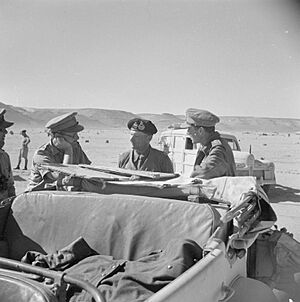
Freyberg was promoted to lieutenant-general in March 1942. He was also knighted. He continued to lead the 2nd New Zealand Division through the North African and Italian campaigns. He was known as a great tactician at the divisional level. Churchill called him his "salamander" because he loved being in the thick of the fighting. He was wounded in June 1942 but quickly returned.
Freyberg had a good relationship with General Bernard Montgomery. Montgomery thought highly of the experienced New Zealand commander.
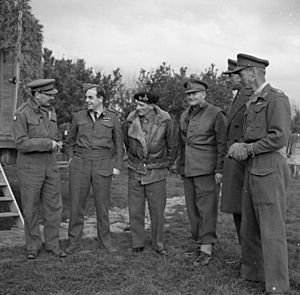
In the important Second Battle of El Alamein (October–November 1942), the 2nd New Zealand Division played a key role. For his leadership, Freyberg was immediately knighted again. As the Axis forces were chased into Tunisia, he led the New Zealanders in clever moves to outflank enemy lines.
In September 1944, Freyberg was injured in a plane accident. After six weeks in the hospital, he returned to lead the New Zealand Division. They made a rapid advance in Italy, covering 250 miles in three weeks. They reached Trieste, freeing Padua and Venice. This success earned him a third bar to his DSO in July 1945. He also received the United States Legion of Merit.
Freyberg was very good at planning big attacks. He showed great concern for his soldiers' well-being. He was a very popular commander with the New Zealand troops and government.
Freyberg was involved in the decision to bomb the ancient monastery at Monte Cassino in February 1944. He believed the abbey was being used by German forces as a stronghold. His commanders agreed that it should be destroyed to prevent its use. After the bombing, German forces did occupy the ruins. After the war, monks said the Germans had not been inside the abbey before the bombing.
After the War
Freyberg left command of the New Zealand division in November 1945. He accepted an invitation to become Governor-General of New Zealand. He was the first Governor-General with a New Zealand upbringing. He started his new role in May 1946. He retired from the army in September 1946.
Freyberg served as Governor-General of New Zealand from 1946 to 1952. He was very active in this role. He visited many parts of New Zealand.
In 1951, King George VI made Freyberg a peer. He became Lord Freyberg.
After his term as Governor-General, Freyberg returned to England. He often attended the House of Lords. In 1953, he became the Deputy Constable of Windsor Castle.
Freyberg passed away at Windsor on July 4, 1963. He was buried in the churchyard of St Martha on the Hill in Surrey. His wife and son are buried beside him.
Tributes and Legacy
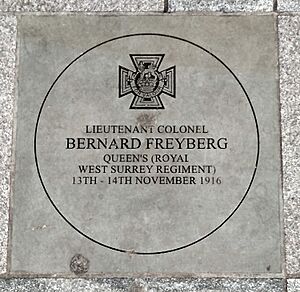
Bernard Freyberg was a great athlete and soldier. Many places are named after him. The Ministry of Defence's headquarters is named after him. There is a stadium in Auckland and a swimming pool in Wellington. The Wellington pool is on the site of his early swimming victories.
Several streets are named after him, including Freyberg Place in Auckland. There is a statue of him there.
Auckland's Freyberg Place opened in 1946. Wellington's Freyberg Pool opened in 1963. Auckland's Freyberg Field opened in 1965. The 15-story Freyberg Building in Wellington was built in 1979. Freyberg High School in Palmerston North opened in 1955.
The Sir Bernard Freyberg Cup is awarded to the winner of single sculls at the New Zealand Rowing Championship.
In November 2016, a blue plaque was put up at his birthplace in Richmond, London. A special paving stone was also unveiled outside Richmond Station to honor his Victoria Cross.


